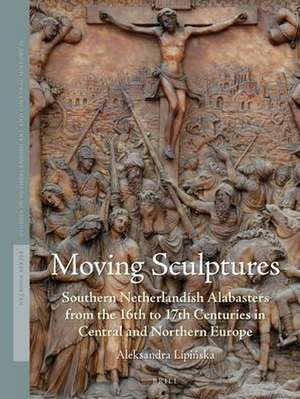Moving Sculptures: Southern Netherlandish alabasters from the 16th to 17th centuries in Central and Northern Europe: Studies in Netherlandish Art and Cultural History, cartea 11
Autor Aleksandra Lipińskaen Limba Engleză Hardback – 14 dec 2014
For sample pages click on Google Books button.
Preț: 647.45 lei
Preț vechi: 789.57 lei
-18% Nou
Puncte Express: 971
Preț estimativ în valută:
123.93€ • 134.66$ • 104.17£
123.93€ • 134.66$ • 104.17£
Carte indisponibilă temporar
Doresc să fiu notificat când acest titlu va fi disponibil:
Se trimite...
Preluare comenzi: 021 569.72.76
Specificații
ISBN-13: 9789004270930
ISBN-10: 9004270930
Pagini: 386
Dimensiuni: 170 x 245 x 30 mm
Greutate: 1.18 kg
Editura: Brill
Colecția Brill
Seria Studies in Netherlandish Art and Cultural History
ISBN-10: 9004270930
Pagini: 386
Dimensiuni: 170 x 245 x 30 mm
Greutate: 1.18 kg
Editura: Brill
Colecția Brill
Seria Studies in Netherlandish Art and Cultural History
Notă biografică
Aleksandra Lipińska, Ph.D. (2003), is a junior professor of the Art History of Central and Eastern Europe at the Technische Universität Berlin. She has published extensively on Early Modern sculpture as well as on the issues of artistic migration and material meaning.
Cuprins
Contents
Acknowledgments vii
List of Figures, Graphs, and Tables ix
Introduction 1
Part 1
At the Source: Production of the Alabaster Sculpture in the Southern Netherlands
1 Alabaster as a Sculpture Material 17
2 Alabaster in Netherlandish Sculpture from the Late Gothic to
the Early Baroque 44
3 Serial Production of Alabaster Sculpture in Mechelen 96
4 The Spread of Alabaster Sculpture from the Low
Countries 124
Part 2
At the Destination: Southern Netherlandish Alabaster Sculpture in Central and Northern Europe
5 Altarpieces 143
6 Tombs and Epitaphs 205
7 Exhibits of Real and ‘Imagined’ Collections 254
8 Alabaster Chambers 271
Epilogue 279
Documents 287
Bibliography 301
Notes 333
Index of Persons 372
Index of Geographic Names 380
Acknowledgments vii
List of Figures, Graphs, and Tables ix
Introduction 1
Part 1
At the Source: Production of the Alabaster Sculpture in the Southern Netherlands
1 Alabaster as a Sculpture Material 17
2 Alabaster in Netherlandish Sculpture from the Late Gothic to
the Early Baroque 44
3 Serial Production of Alabaster Sculpture in Mechelen 96
4 The Spread of Alabaster Sculpture from the Low
Countries 124
Part 2
At the Destination: Southern Netherlandish Alabaster Sculpture in Central and Northern Europe
5 Altarpieces 143
6 Tombs and Epitaphs 205
7 Exhibits of Real and ‘Imagined’ Collections 254
8 Alabaster Chambers 271
Epilogue 279
Documents 287
Bibliography 301
Notes 333
Index of Persons 372
Index of Geographic Names 380
Recenzii
"Moving Sculptures is an impressive and much-needed book. It addresses a great number of concerns that have become central to the discipline: the materiality of artworks, the art market, the consequences of the Reformation for the visual arts, concepts of civic and courtly identity and their markers, and many others. Lipińska’s book also manages to offer a concentrated overview of Netherlandish antique sculpture, its main genres, and its chief practitioners.
Ethan Matt Kavaler, University of Toronto
"This English re-edition of Aleksandra Lipinska’s study on Southern Netherlandish alabasters most definitely fills an important gap in the research on Flemish sculpture and its dissemination in Europe."
"..., Lipinska’s excellent, broad-ranging study provides a perfect stimulus for further research into the “consumption” of these exquisite works of art in the broader patrician circles of Central and Northern Europe."
Valerie Herremans, Koninklijk Museum voor Schone Kunsten Antwerpen
"Lipinska’s Moving Sculptures is beautifully researched, lucidly argued, and wonderfully informative. It should appeal to any scholar interested in the history of materials, the methods of artistic production, the rise of early modern art markets, and the aesthetics of taste and reception. Lipinska includes a small selection of relevant letters and other documents. Her superb English-language edition deserves a wide audience."
Jeffrey Chipps Smith, University of Texas at Austin
Ethan Matt Kavaler, University of Toronto
"This English re-edition of Aleksandra Lipinska’s study on Southern Netherlandish alabasters most definitely fills an important gap in the research on Flemish sculpture and its dissemination in Europe."
"..., Lipinska’s excellent, broad-ranging study provides a perfect stimulus for further research into the “consumption” of these exquisite works of art in the broader patrician circles of Central and Northern Europe."
Valerie Herremans, Koninklijk Museum voor Schone Kunsten Antwerpen
"Lipinska’s Moving Sculptures is beautifully researched, lucidly argued, and wonderfully informative. It should appeal to any scholar interested in the history of materials, the methods of artistic production, the rise of early modern art markets, and the aesthetics of taste and reception. Lipinska includes a small selection of relevant letters and other documents. Her superb English-language edition deserves a wide audience."
Jeffrey Chipps Smith, University of Texas at Austin







